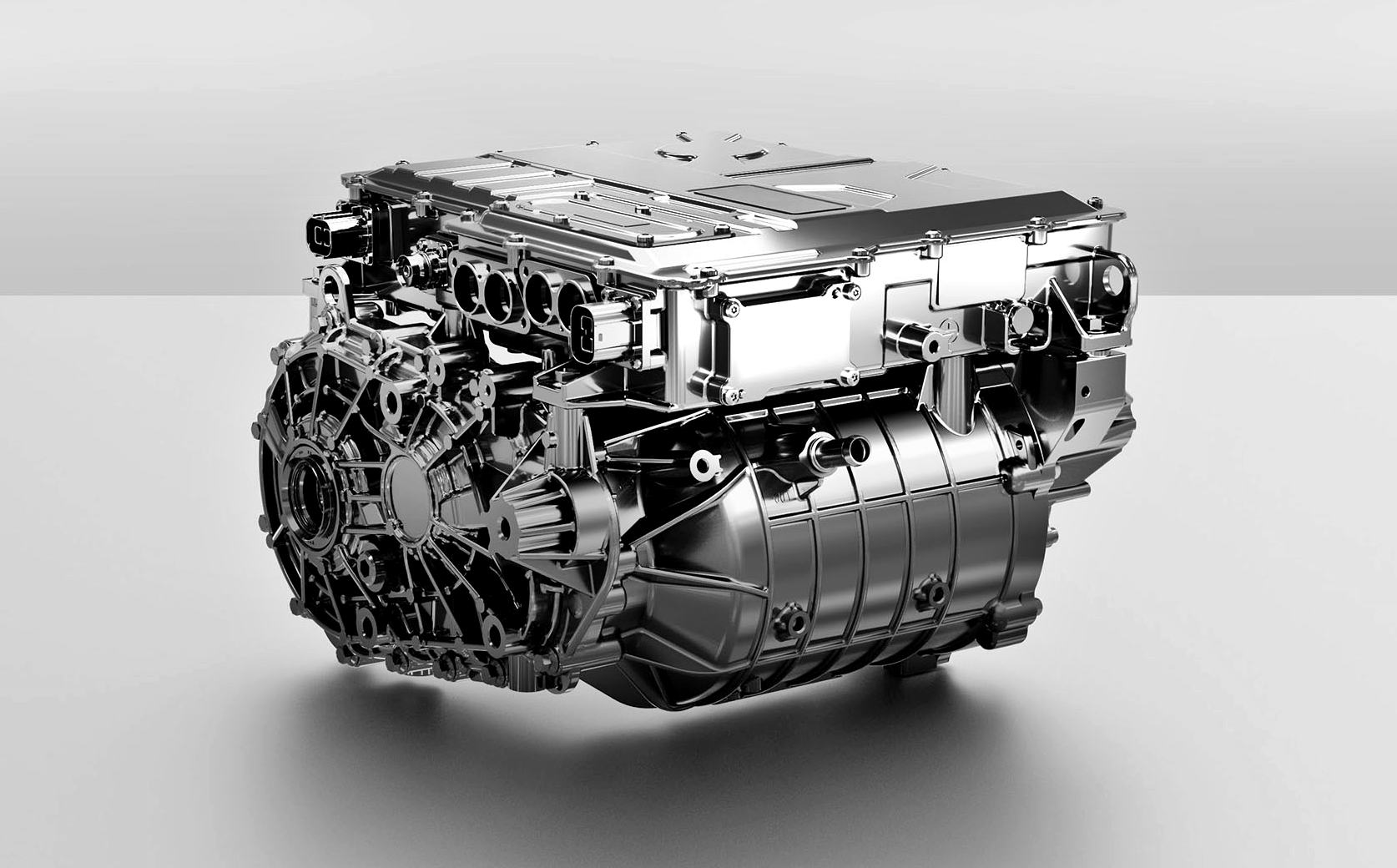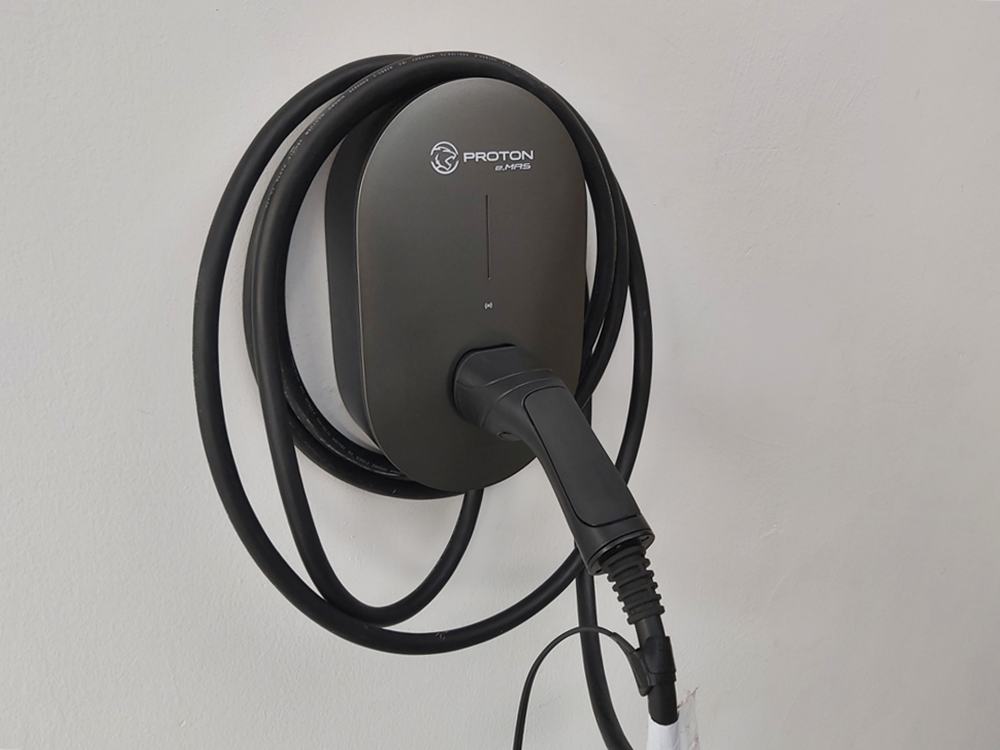It’s become standard practice for PROTON to offer its new models to the media to drive before the official launch and with the e.MAS 5 due to be launched in the very near future, we got to try it out at the PROTON test track (thought the factory has closed down, the test track is still in use) this week.
The cars we drove were imported CBU units from China as the first units from the plant in Tg. Malim, Perak have not rolled out yet. Anyway, the objective was to experience the driving and performance of the EV rather than cover the features and build quality (which was pretty good anyway).
![Proton e.MAS 5 EV [2025]](https://www.motaauto.com/wp-content/uploads/2025/10/Proton-e.MAS-5-EV-2025-13-e1760675750159.jpg)
Though available in Prime and Premium versions, there is only a single motor drivetrain, mounted at the back so there is rear-wheel drive. The compact 11-in-1 drivetrain generates 85 kW (115.6 ps)/150 Nm, which is rather like what you get from today’s 1.5-litre combustion engines. Up to 89.2% of the output gets to the wheels so energy efficiency is high.


The lithium iron phosphate (LFP) battery pack is from CATL (the world’s largest EV battery supplier) and has a capacity of 40.16 kWh. It is said to be good for a range of up to 325 kms. Fast-charging can be done with a DC supply of up to 71 kW which will ‘fill’ the battery from 30% to 80% within 21 minutes, it is claimed.
Like any EV, the e.MAS 5 runs noiselessly and I thought that sound insulation was pretty good, considering that this is a small car and it is also not a premium product (like a smart #1). When the running is so quiet, you start to hear outside noises like wind and road noise but I didn’t notice these.
![Proton e.MAS 5 EV [2025]](https://www.motaauto.com/wp-content/uploads/2025/10/Proton-e.MAS-5-EV-2025-6.jpg)
While acceleration was typical of an EV, with a surge from standstill because maximum torque is available, there wasn’t the sustained zip with this Proton. It was quick but somehow it didn’t feel as quick as other EVs. Sometimes, this may be the fact that the quietness masks the sensations of speed but I think that is not the case.
The 30-year old test course also has large areas for handling tests and we did slaloms and figure-of-eights to experience the manoeuvrability. Rear-wheel drive and the multi-link rear suspension figure strongly in the character of the e.MAS 5, giving it nimbleness and responsiveness to steering inputs.
![Proton e.MAS 5 EV [2025]](https://www.motaauto.com/wp-content/uploads/2025/10/Proton-e.MAS-5-EV-2025-8.jpg)
It’s possible to take tight lines through the slalom as grip is strong and roll is well controlled. That allows a high speed going between the cones as you don’t have to go in a wider arc to reduce roll. Like the e.MAS 7, the steering wheel in the e.MAS 5 has a nice texture which makes gripping comfortable and firm.
The figure-of-eight test showed the EV to be very easy to manoeuvre, with its compact size being an advantage. That’s good for parking and what makes things even easier is the all-round monitor which shows the car from all sides (even above) on the centre display. There will really be no excuse for not being able to position the car in a bay properly!
Improving user interface
Some quick comments about the controls which are a combination of switches and touchscreen. In the first year of testing EVs, it seemed that the emphasis on touchscreen controls was not so practical. Everything had to be done by touching the screen – even adjusting the fan speed. In some cars, you even have to use screen controls to adjust the door mirrors.
![Proton e.MAS 5 EV [2025]](https://www.motaauto.com/wp-content/uploads/2025/10/Proton-e.MAS-5-EV-2025-17.jpg)
I thought about this for a while and it might be that those who designed the user-interface (UX) imagine that all drivers are safety conscious. When they need to make an adjustment, they will stop the car and do it, so it should not be troublesome to press a button on the screen. But… how many people really do that? For most drivers, adjusting the fan speed is done by reaching to a knob and turning it – you probably don’t even look at it. And you don’t stop the car to do it.
![Proton e.MAS 5 EV [2025]](https://www.motaauto.com/wp-content/uploads/2025/10/Proton-e.MAS-5-EV-2025-15.jpg)
Globally, there’s been a lot of criticism of diminishing use of physical switches and interior designers have been taking note. A number of automakers have said that they will have a better balance of physical switches and some of the more recent models, like the e.MAS 5, show a sensible approach.
![Proton e.MAS 5 EV [2025]](https://www.motaauto.com/wp-content/uploads/2025/10/Proton-e.MAS-5-EV-2025-10.jpg)
There’s also increasing familiarity with using touchscreens that may make things easier nowadays. Having driven a number of EVs, I know that I need to take a little while to get all the settings right to enjoy driving. A real owner would have more time and patience to get things just right, and become familiar with the operations within a short time.
Software refinement
The other thing that I have noticed is that the software has evolved a bit in the past few years. For example, 3 years ago, there was criticism of the regeneration characteristics which were too abrupt. While regeneration helps to recharge a little bit as you drive, the way it worked was irritating that many people switched it off or to minimum.
Today, the regeneration mode in most EVs is more refined without losing efficiency. It’s been a matter of programming and that is not really difficult. The good thing for those who buy an EV with, say ‘version 1.0’ of the software is that they won’t lose out and be stuck with the unrefined character. They won’t have to change to a new or updated model either but they will still enjoy the improvements.
![Proton e.MAS 5 EV [2025]](https://www.motaauto.com/wp-content/uploads/2025/08/Proton-e.MAS-5-EV-2025-3.jpg)
This is thanks to the OTA (Over the Air) service which many modern cars have. Periodically, updates to software will be transmitted by PRO-NET to all e.MAS cars and they automatically update the systems. Not only are there improvements but sometimes even additional features are provided. So those with older models can have their systems updated to be the same as what new owners get, keeping their cars ‘fresh’ for a longer period.
EV vs ICE – running costs
For those who are wondering just how much they could save if they buy a car that runs on electricity compared to using one that runs on petrol, PRO-NET has come up with some figures that clearly favour an EV, no argument.

Using the e.MAS 5 as the EV example and a typical ICE car which has around 12.5 kms/litre of fuel consumption, they calculated the costs of charging over a 10-year period at 2,000 kms a month. The e.MAS 5 has a claimed energy consumption of 12.3 kWh per 100 kms.
Their basis of costs for charging uses AC charging (typically a wall charger at home) at the most favourable TNB rate (off-peak) which is 0.4183 sen per kWh. For petrol cost, they use the cheapest available which is RON95 with the BUDI95 subsidy so it is RM1.99/litre. Of course, these can change over time too and given that they project over a 10-year period (which is rather long), there are almost certainly going to be changes.
![Proton e.MAS 5 EV [2025]](https://www.motaauto.com/wp-content/uploads/2025/08/Proton-e.MAS-5-EV-2025-30.jpg)
For ICE car, the total cost of fuel in that time (based on today’s rate) would be RM38,208 whereas the e.MAS 5 owner would spend around RM12,500. That’s a difference of 68% – quite wide so even with variations over time, an EV would still be cheaper to recharge than buying liquid fuel.
But as I often remind readers about fuel consumption claims by car companies, they are the best numbers that are achieved on factory tests. Some driving cycles used for testing are realistic and some are not. So the numbers advertised can be taken as the best possible and then, depending on your driving style and conditions, it may be less (or could even be better in some cases).
![Proton e.MAS 5 EV [2025]](https://www.motaauto.com/wp-content/uploads/2025/10/Proton-e.MAS-5-EV-2025-12.jpg)
With EVs, as with ICE cars, consumption of energy rises if you drive harder. If you are the type who wants to experience strong acceleration and keep pressing hard on the throttle, then your fuel consumption will be higher and you should not complain. Likewise, with an EV, many may love the stronger acceleration that an electric motor gives, especially when starting off, and accelerate harder than they need to. That too will raise energy consumption so the range will be less.
But an EV does have an advantage in cities and slow-moving traffic. Low speeds and stop/start driving have less impact on energy consumption whereas an ICE car would tend to burn more fuel, especially when idling for long periods.
Even better, you don’t have to worry about the air-conditioner affecting fuel consumption because the systems in EVs run electrically and consumption is not high. In fact, you could leave the air-conditioner on overnight while sleeping in the EV and still have enough charge the next day to continue your journey. That’s why when you go to showrooms with EVs, the lights are on and the air-conditioner is also running!
Much lower maintenance costs
As for maintenance costs, PRO-NET has also come up with some figures, again based on the e.MAS 5 and compared against a comparably sized ICE model, perhaps the Saga or Iriz. For the ICE model, around RM6,750 would spend over 10 years of ownership (based on current prices). This would be for labour charges, fluids and replacement of parts (excluding tyres).
The e.MAS 5, on the other hand, requires less maintenance and has less parts to replace. Periodic maintenance is still necessary as fluids need to be replaced after a while. Over 10 years, an owner would spend around RM2,700 (based on current prices). That’s a big difference of almost 190% and the wide gap means that even with prices changing over time, you will still save a lot if you use an EV.
![Proton e.MAS 5 EV [2025]](https://www.motaauto.com/wp-content/uploads/2025/10/Proton-e.MAS-5-EV-2025-14.jpg)
Is it time to go electric?
It’s almost a ‘no brainer’ that switching to an EV is a very good idea. The various concerns that existed 3 years ago are slowly being addressed, eg range on a full charge has increased substantially. The network of charging stations grows each month and PRO-NET has been working hard to help owners who live in high-rise buildings to have chargers installed. For most people, overnight charging is probably fine for daily commuting. It is only when going out of town on holiday or balik kampung that planning is needed to find out where the charging stations are located along the route.
Charging times are also reducing and while it can take 20 – 30 minutes to recharge from 30% to 80%, it is not necessary to go by that time-frame. Recharging for a short while – 15 minutes or so – can provide additional range to cover the rest of the journey or as a ‘reserve’.
Click here to find a Proton e.MAS showroom
Game-changer in EV segment
PROTON has indicated that the price of the e.MAS 5 will be between RM60,000 and RM80,000, which surprised me. At that price level and with a booking fee of just RM99, it’s not surprising that they have 3,000 bookings within the first 7 days of the price announcement.
The price of the e.MAS 5 could be the game-changer in the EV market, encouraging more Malaysians to switch to EVs. It would be just like the original Saga which was priced at around RM17,000 and made it possible for more Malaysians to own a car, and for those on motorcycles to switch to something that would protect them better from the sun and rain.

![Proton e.MAS 5 EV [2025] Proton e.MAS 5 EV [2025]](https://www.motaauto.com/wp-content/uploads/2025/10/Proton-e.MAS-5-EV-2025-7-696x358.jpg)

